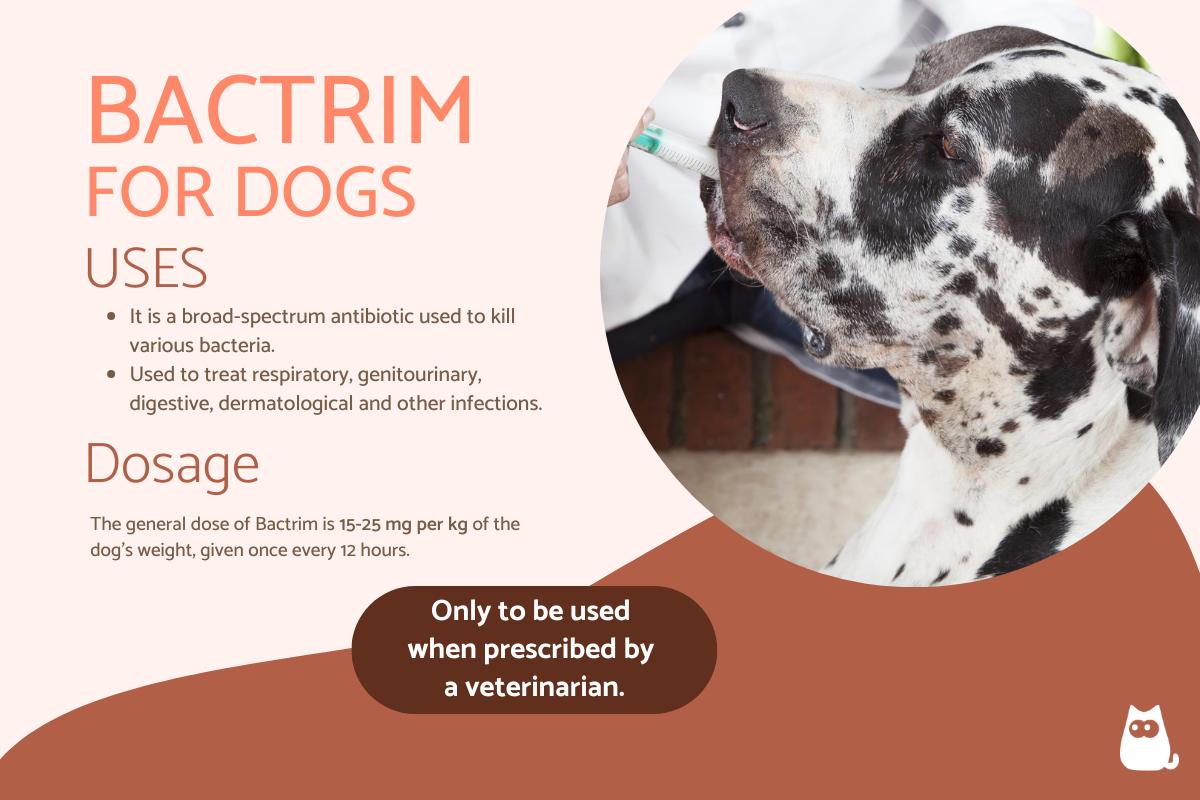Bactrim for Dogs - Dosage, Uses and Side Effects



See files for Dogs
Bactrim in dogs is a type of antibiotic with the active ingredients trimethoprim and sulfamethoxazole. The use of these two antimicrobial compounds in combination has a synergistic effect, meaning the effect of both drugs is increased when administered together. Trimethoprim/sulfamethoxazole is a drug on the World Health Organization's List of Essential Medicines. Bactrim is used to treat a variety of bacterial infections which can affect a canine. Although common, it will need to be prescribed by a veterinarian before it can be administered to your dog.
Learn more about Bactrim for dogs with AnimalWised. We look at the uses, dosage and side effects of trimethoprim/sulfamethoxazole so you can know what to expect if your dog is prescribed this antibiotic.
What is Bactrim for dogs?
Bactrim is an antibiotic drug that combines the two active ingredients trimethoprim and sulfamethoxazole. It is a medicine most commonly used in human medicine, including pediatrics. Its use in veterinary medicine has increased over recent years. There are several veterinary drugs analogous to this one that also combine trimethoprim with sulfonamides such as sulfadiazine.
Both trimethoprim and sulfamethoxazole act by inhibiting bacterial DNA synthesis, although acting on different levels. Trimethoprim inhibits the enzyme dihydrofolate reductase, while sulfamethoxazole acts by inhibiting dihydropteroate synthase. The combination of both antibiotics has a bactericidal effect, i.e. they cause the death of bacteria.
The reason these two active ingredients are combined is that together they have a synergistic effect. This means used in combination they produce a markedly superior response to that which would be obtained with the two compounds separately. In fact, it is known that when both compounds are combined, their action is effective on 40% of bacteria that could be resistant to either of the components separately.
Find out whether another drug in human medicine can be used in dogs with our article on dosage and uses of Augmentin for dogs.
Can Bactrim be used for dogs?
Bactrim in dogs is currently available in tablet and oral suspension form. However, medicinal products containing the same active ingredients as Bactrim are also available as an injectable solution for intramuscular, intravenous and subcutaneous administration.
Bactrim is also sold under other brand names such as Trisul, Cotrim and Septra. Few of these are sold specifically for veterinary use. In fact, Bactrim is not yet FDA approved for veterinary use. This does not mean it is ineffective, simply that its approval is pending. Studies have shown efficacy in veterinary medicine and it is commonly prescribed[1]. A trusted veterinarian will know the right antibiotic to prescribe. If they prescribe Bactrim it is likely because it will be the most effective for the dog's needs.
Uses of Bactrim for dogs
As an antibiotic, Bactrim is used to treat various bacterial infections. Generally, this broad-spectrum antibiotic is used for the treatment of systemic infections (respiratory, digestive, genitourinary, dermatological, etc.) caused by:
- Gram negative bacteria (e.g. kennel cough caused by Bordetella bronchiseptica)
- Aerobic gram positive bacteria (especially for Nocardia and Staphylococcus infections)
- Some protozoa (e.g. Toxoplasma and Coccidia)
- Pneumonia
- Prostate infections
Learn more about canine protozoan infections with our guide to coccidia in dogs.
Bactrim for dogs dosage
As we have already mentioned, Bactrim is available in tablet, oral suspension and intravenous forms. It is most commonly administered orally. Specifically, the dose of Bactrim is 15-25 mg per kg of the dog's weight, given once every 12 hours. It can be given with or without food and treatments usually last for 5 days, but can be longer depending on the severity of the infection.
Although Bactrim can be provided in stronger doses for human use, Bactrim for veterinary use will often use the following preparations:
- Bactrim 20 mg/100 mg tablets: one tablet should be administered for every 5 kg of body weight, every 12 hours. To prevent your dog from spitting out the tablet, place at the back of their throat and keep the mouth closed while gently massaging their throat until they swallow. If this method is not effective, you can hide the tablet in a treat or their regular food.
- Bactrim 8 mg/40mg/ml in oral solution: 1 ml should be administered for every 2 kg of weight, every 12 hours. Once you have loaded the oral solution into a syringe, lift the dog's lip, insert the syringe behind the fangs and slowly squeeze the contents into the oral cavity.
Bactrim as an injection will likely only be administered by a veterinarian at the clinic when necessary. This is much less commonly used than tablet or oral solution form.
Side effects of Bactrim for dogs
The administration of pediatric Bactrim in dogs can cause the appearance of:
- Hematopoietic alterations: these are alterations in the synthesis of the different cellular components of the blood.
- Alterations in the kidney and urinary tract: such as renal obstruction, crystalluria (presence of crystals in the dog's urine) and hematuria (presence of blood in the dog's urine).
To avoid kidney damage due to urolith formation, we must ensure the animal is kept well hydrated during treatment with Bactrim. For this, it is essential that you always have fresh and clean water freely available.
Contraindications of Bactrim for dogs
Although Bactrim (trimethoprim/sulfamethoxazole) is a very effective drug for the treatment of multiple systemic infections, there are a number of situations in which its administration can be counterproductive in dogs. Specifically, the contraindications of Bactrim in dogs are the following:
- Allergy or hypersensitivity to trimethoprim, sulfamethoxazole or any of the excipients
- Severe liver or kidney damage
- Dehydration
- Alteration in blood cells (red blood cells, white blood cells and/or platelets)
- Treatments with para-aminobenzoic acid (PABA)
- Treatments with oral anticoagulants
- Treatments with urinary acidifiers
Again, it is important that we insist that you should never administer Bactrim to a dog without the prior authorization of a veterinarian. Doing so could seriously worsen their situation. Learn more about other antibiotics in veterinary medicine with our article on clindamycin for dogs.
This article is purely informative. AnimalWised does not have the authority to prescribe any veterinary treatment or create a diagnosis. We invite you to take your pet to the veterinarian if they are suffering from any condition or pain.
If you want to read similar articles to Bactrim for Dogs - Dosage, Uses and Side Effects, we recommend you visit our Medicine category.
1. Brooks, W. (2020). Trimethoprim-Sulfa (Bactrim, Tribrissen, Septra, Sulfatrim, Cotrim). Retrieved from:
https://veterinarypartner.vin.com/default.aspx?pid=19239&id=4951493
- Spanish Agency for Medicines and Health Products (AEMPS). SPC septrin pediatric 8 mg/40mg/ml oral suspension. Retrieved from: https://cima.aemps.es/cima/dochtml/ft/48671/FT_48671.html
- Spanish Agency for Medicines and Health Products (AEMPS). SPC septrin pediatric 20 mg/100mg tablets. Retrieved from: https://cima.aemps.es/cima/dochtml/ft/48669/FT_48669.html
- Spanish Agency for Medicines and Health Products (AEMPS). Technical sheet or summary of product characteristics: censulfatrim injectable solution. Retrieved from: https://cimavet.aemps.es/cimavet/pdfs/es/ft/3358+ESP/FT_3358+ESP.pdf





